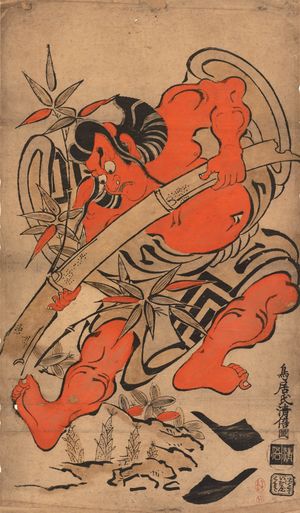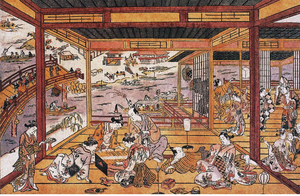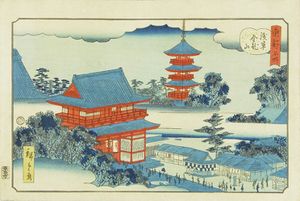الطباعة بالقوالب الخشبية في اليابان


Metropolitan Museum of Art

Taking the Evening Cool by Ryōgoku Bridge, ح. 1745
Woodblock printing in Japan (木版画, mokuhanga) is a technique best known for its use in the ukiyo-e artistic genre of single sheets, but it was also used for printing books in the same period. Widely adopted in Japan during the Edo period (1603–1868) and similar to woodcut in Western printmaking in some regards, the mokuhanga technique differs in that it uses water-based inks—as opposed to western woodcut, which typically uses oil-based inks. The Japanese water-based inks provide a wide range of vivid colors, glazes, and transparency.
التاريخ
In 764 the Empress Kōken commissioned one million small wooden pagodas, each containing a small woodblock scroll printed with a Buddhist text (Hyakumantō Darani). These were distributed to temples around the country as thanks for the suppression of the Emi Rebellion of 764.[1] These are the earliest examples of woodblock printing known, or documented, from Japan.
التقنية

المدارس والحركات

Japanese printmaking, as with many other features of Japanese art, tended to organize itself into schools and movements. The most notable schools (see also schools of ukiyo-e artists) and, later, movements of moku-hanga were:
- Torii school, from 1700
- Kaigetsudō school, from 1700–14
- Katsukawa school, from about 1720s, including the artists Shunsho and Shuntei[2]
- Kawamata school, from about 1725, including the artists Suzuki Harunobu and Koryusai[2]
- Hokusai school, from about 1786, including the artists Hokusai, Hokuei and Gakutei [2]
- Kitagawa school, from about 1794, including the artists Utamaro I, Kikumaro I and II[2]
- Utagawa school, from 1842, including the artists Kunisada and Hiroshige[2]
- Sōsaku-hanga, "Creative Prints" movement, from 1904
- Shin-hanga "New Prints" movement, from 1915, including Hasui Kawase and Hiroshi Yoshida [3]
مقاسات الطبع
Following are common Tokugawa-period print sizes. Sizes varied depending on the period, and those given are approximate; they are based on the pre-printing paper sizes, and paper was often trimmed after printing.[4]
| name | trans. | cm (in) | ref |
|---|---|---|---|
| koban (小判) | small about 1⁄4 the size of ōban |
19.5 × 13 (7.7 × 5.1) | |
| aiban (合判) | intermediate | 34 × 22.5 (13.4 × 8.9) | [4] |
| bai-ōban (倍大判) | intermediate | 45.7 × 34.5 (18.0 × 13.6) | [5] |
| chūban (中判) | medium | 26 × 19 (10.2 × 7.5) | [4] |
| hashira-e (柱絵) | pillar print | 73 × 12 (28.7 × 4.7) | [4] |
| hosoban (細判) or hoso-e (細絵)[5] |
narrow | 33 × 14.5 (13.0 × 5.7) | [4] |
| 39 × 17 (15.4 × 6.7) | [4] | ||
| kakemono-e (掛物絵) | hanging scroll | 76.5 × 23 (30.1 × 9.1) | [4] |
| nagaban (長判) | long | 50 × 20 (19.7 × 7.9) | [4] |
| ōban (大判) | large | 38 × 25.5 (15.0 × 10.0) | [4] |
| 58 × 32 (23 × 13) | [4] | ||
| ō-tanzaku (大短冊判) | large poem card | 38 × 17 (15.0 × 6.7) | [4] |
| chū-tanzaku (中短冊判) | medium poem card | 38 × 13 (15.0 × 5.1) | [4] |
| surimono (刷物) | 35 × 20 (13.8 × 7.9) | [4] | |
| 12 × 9 (4.7 × 3.5) – 19 × 13 (7.5 × 5.1) |
[4] |
The Japanese terms for vertical (portrait) and horizontal (landscape) formats for images are tate-e (立て絵) and yoko-e (横絵), respectively.
الهامش
- ^ http://www.schoyencollection.com/Pre-Gutenberg.htm#2489
- ^ أ ب ت ث ج The Prints of Japan, Frank A. Turk, October House Inc ,1966, Lib Congress catalog Card no. 66-25524
- ^ Fresh Impressions, Kendall Brown, Publisher: University of Washington Press, September 2013, ISBN 0935172513
- ^ أ ب ت ث ج ح خ د ذ ر ز س ش ص Faulkner & Robinson 1999, p. 40.
- ^ أ ب Harris 2011, p. 31.
المراجع
- Faulkner, Rupert; Robinson, Basil William (1999). Masterpieces of Japanese Prints: Ukiyo-e from the Victoria and Albert Museum. Kodansha International. ISBN 978-4-7700-2387-2.
{{cite book}}: Invalid|ref=harv(help) - Forrer, Matthi, Willem R. van Gulik, Jack Hillier A Sheaf of Japanese Papers, The Hague, Society for Japanese Arts and Crafts, 1979. ISBN 90-70265-71-0
- Harris, Frederick (2011). Ukiyo-e: The Art of the Japanese Print. Tuttle Publishing. ISBN 978-4-8053-1098-4.
{{cite book}}: Invalid|ref=harv(help) - Kaempfer, H. M. (ed.), Ukiyo-e Studies and Pleasures, A Collection of Essays on the Art of Japanese Prints, The Hague, Society for Japanese Arts and Crafts, 1978. ISBN 90-70216-01-9
- Nussbaum, Louis Frédéric and Käthe Roth. (2005). Japan Encyclopedia. Cambridge: Harvard University Press. ISBN 978-0-674-01753-5; OCLC 48943301
- Friese, Gordon (2007). "Hori-shi. 249 facsimiles of different seals from 96 Japanese engravers." Unna, Nordrhein-Westfalen: Verlag im bücherzentrun.
- Lane, Richard. (1978). Images from the Floating World, The Japanese Print. Oxford: Oxford University Press. ISBN 9780192114471; OCLC 5246796
- Paine, Robert Treat, in: Paine, R. T. & Soper A, "The Art and Architecture of Japan", Pelican History of Art, 3rd ed 1981, Penguin (now Yale History of Art), ISBN 0140561080.
- Sansom, George (1961). "A History of Japan: 1334–1615." Stanford, California: Stanford University Press.
- Rikardson, Anders (1978). "Japanese Woodblock Prints" Malmö: Antik & Auktion.
للاستزادة
- Whitmore, Paul M.; Cass, Glen R. (February 1988). "The Ozone Fading of Traditional Japanese Colorants". Studies in Conservation. Maney Publishing on behalf of the International Institute for Conservation of Historic and Artistic Works. 33 (1): 29–40. doi:10.1179/sic.1988.33.1.29. JSTOR 1506238.
وصلات خارجية
- Chikanobu and Yoshitoshi Woodblock Prints in the Claremont Colleges Digital Library
- Ukiyo-e Caricatures 1842–1905 Database of the Department of East Asian Studies of the University of Vienna
- The process of woodblock printing Movie by Adachi Woodcut Print
- Contemporary Japanese prints from the 50th anniversary of the College Women's Association of Japan Print Show
- Japanese prints ukiyo-e
- Digitized Japanese woodblock prints at UCSF
